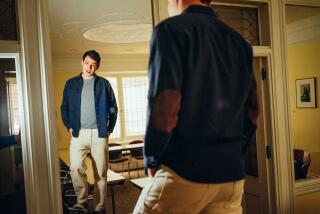Art review: ‘Sharon Lockhart | Noa Eshkol’ at LACMA is respectful
- Share via
Sharon Lockhart discovered the work of Israeli artist, choreographer and dance theorist Noa Eshkol not long after Eshkol died in 2007 — a circumstance that lends a peculiar slant to the collaboration that was subsequently undertaken between them, and that is the basis for their dual exhibition at the Los Angeles County Museum of Art.
The collaboration, strictly speaking, was between Lockhart, an L.A.-based photographer and filmmaker, and Eshkol’s legacy, which is to say her dancers and the system she is known for developing, Eshkol-Wachman Movement Notation. (Established in collaboration with architect Avraham Wachman in the mid-1950s, the system uses numbers and symbols to chart spatial relationships between parts of the body.) Acting as artist, documentarian, archivist and curator almost simultaneously, Lockhart filmed the dancers performing Eshkol’s meticulous compositions, gathered and photographed archival materials related to EWMN, and assembled a selection of Eshkol’s visual works — tapestries — for inclusion in the exhibition.
The result is a sensitive portrait of a formidable artist, one all but unknown outside her home country, as seen through the eyes of another artist of a different discipline, several generations and thousands of miles removed. The affinities are subtle but striking. Both favor a clear and direct aesthetic. Both are fascinated by the relationship between geometry and the body, formalism and the human environment. Lockhart’s film of Eshkol’s dances, a five-channel installation that weaves through several adjacent rooms, presents the dancers full size and at ground level, moving to the rhythm of a resounding metronome, such that they seem to mingle with the museum visitors — an approach that underscores the fundamentally humanistic nature of both artists’ motivations.
There is another element of the film, however, that draws a conspicuous distinction: the inclusion of several of Eshkol’s tapestries — “wall carpets,” as she called them, made from colorful scraps of discarded fabric — as set pieces, pinned to free-standing vertical blocks. Eshkol, as is repeatedly noted throughout the catalog, would probably not have approved. A purist who sought in her dances to “relinquish the use of all tools that are not inherently related to movement” (including costumes, music and dramatic lighting), she considered the “wall carpets” to be separate works, unrelated to the dances.
The inclusion is perplexing less for its heresy than the great disservice it does to the tapestries. In the film, they come across as irrelevantly decorative, if not a little tacky. In person, however, installed as three of them are in the last room of the exhibition, they’re marvelous: intricate, dynamic and joyously colorful, so rich with associations to the tactile world that they seem almost to be breathing. In the context of the exhibition, they provide a useful entry into the social and political backdrop of Eshkol’s career — born in 1924 on one of the first kibbutzim in Israel, she was the daughter of Israel’s third prime minister; the first of the tapestries was produced during the Yom Kippur War of 1973 — as well as what many will consider a welcome respite from the relative severity of the dances.
Elective set decorations notwithstanding, Lockhart’s exceedingly respectful handling of Eshkol’s vision makes it easy for viewers to come to a similar admiration — an act of generosity that surely benefits both artists in the end.
More to Read
The biggest entertainment stories
Get our big stories about Hollywood, film, television, music, arts, culture and more right in your inbox as soon as they publish.
You may occasionally receive promotional content from the Los Angeles Times.










